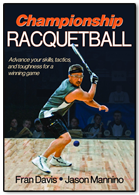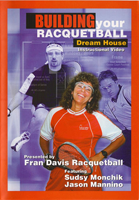 Taking the right shot at the right time means making your opponent run the farthest distance to get to the ball. When many get into the heat of the battle, they don’t think about shot selection—but just bang away and play what we call survival racquetball. Or, they go for a favorite rather than one that can win the rally, putting their opponent on the defense. Here’s how to determine your best shot, and how to make it when you need to most.
Taking the right shot at the right time means making your opponent run the farthest distance to get to the ball. When many get into the heat of the battle, they don’t think about shot selection—but just bang away and play what we call survival racquetball. Or, they go for a favorite rather than one that can win the rally, putting their opponent on the defense. Here’s how to determine your best shot, and how to make it when you need to most.
The best shot depends on the player, the ball, the opponent, and score.Here is a simple formula that summarizes how to determine what shot to use in any given situation, during the rally as well as on the return of serve. All four of these factors are important for deciding your shot selection. Let’s take a closer look.
A = You (court position and skill level)
B = Ball (height, speed, and angle)
C = Opponent (court position and skill level)
D = Score (of the game or match)
E = Shot selection (which shot to take)
Use the techniques in my book, “ Championship Racquetball” to understand “Shot Selection” in detail (Chapter 6, page 159-162).
Understanding Shot Selection is a core principle I use with my “Championship Team,” Rocky, Paola, Jason, Taylor, Sharon, Connor, Jordan, and Wayne, and they do know the importance of it. I encourage each and every one of them to use smart shot selection, as they know it makes their opponent run the furthest distance to get to the ball eliciting more mistakes as their opponents are hitting on the run rather than having time to set their feet. This creates more opportunities for them to make an offensive shot and win the point or put their opponent on the defense.
Jason had impeccable shot selection against Sudsy, Cliff and John Ellis and it worked brilliantly. Rocky uses smart shot selection against Kane, Alvaro, Jose and Ben and it also works beautifully.
Let’s examine what tools Rocky, Paola, Jason and all of my athletes use for smart “Shot Selection” by taking a closer look at all 3 sides of The Sports Racquetball Triangle: Conditioning, Mental, and Physical Skills
Left Side of the Triangle
In November, we discussed stretching and the importance of warming up your body’s core temperature and warm up your muscles, tendons and ligaments.
Your workout should include three styles of stretching, all of which are beneficial when used at the correct time in a workout session.
1. Dynamic stretching, which is stretching while you are moving.
2. Ballistic stretching, which is stretching while you are skipping.
3. Static stretching, which is stretching while standing still, sitting, or lying of the ground.
It has been proven through many studies on many types of athletes that it is best to begin every workout session or racquetball match with dynamic stretching. You will warm the muscles with many different exercises while stretching at the same time. Ballistic stretching will also be added to your warm-up, but it is more intense and should be done when your muscles are warm. You also have the option of static stretching, but this type of stretching should be done when you are completely warm and you believe there are body parts that need specific stretches to get you ready to compete at your highest level.
Use the stretching exercises in my book, “ Championship Racquetball” to understand your conditioning level. This will lead to smarter “Shot Selection” as you will be able to set up on balls more quickly and with better reach and therefore shoot the correct shot in a given situation.
(Chapter 10, pages 252-255).
You want to make sure you are routinely eating right and drinking lots of water as your body and mind NEEDS this in order to think clearly and concentrate on the components used for smart “Shot Selection Formula”… You, the Ball, Your Opponent and the Score.
***Check my book, “Championship Racquetball” for specific information on your NUTRITIONAL needs.
Right Side of the Triangle
Mental Skills
Ideally, you want to get into a state of total concentration and focus on the court because that is when you play your best. In other words, you concentrate on the game and focus on the ball and your opponent.
There are two types of focus: broad and pinpoint. When you have a broad focus, you are taking a 360-degree peripheral check as to what is going on around you on the court; you see the whole court, your opponent, and the shots you want to hit.
When you have a pinpoint focus, you are focusing on the center of the ball with laser intensity. The more precise, intense, and accurate your focus, the more consistent you become. You have to see the shot in your mind’s eye before you can unleash the perfect shot.
You start with a broad focus to see all of the court and where your opponent is standing. Then once the point starts, you switch instantly to pinpoint focus.
Use the mental skills in my book, “ Championship Racquetball” to understand focusing when you are on the court, which will help you with smarter “Shot Selection”(Chapter 9, pages 228-229).
Base of the Triangle
Physical Skills
Off the Court
1. Use a diagram of a blank court.
2. Place an O for the offensive player somewhere in the court.
3. Now put a D for the defensive player somewhere on the court.
4. Now write down the 3 best shots to take based on where the offensive player is on the court and where the defensive player is on the court.
5. Keep repeating steps 1-3 by changing the positions of the O and D players until you are very proficient at knowing what shot you, the offensive player, should take based on the position of the defensive player, your opponent.
On the Court
1. Grab a towel or your racquetball bag.
2. Place the towel or bag to represent the defensive player somewhere in the court.
3. Now put yourself on the court and based on where you are on the court and where the towel or racquetball bag is on the court practice hitting the 3 best shots in that given situation.
4. Keep repeating steps 1-3 by changing the positions of you and the towel or racquetball bag until you are very proficient at knowing what shots to hit given the position of where you are on the court, the offensive player, and where your opponent is on the court, the defensive player.
Make sure, as we have done in the past, track your progress by choosing the shot and then do a certain amount of those shots and then keep track how many good ones out of that total # you did. As you practice more and more of them and you are more and more focused you will get more and more consistent at smart “Shot Selection”.
ALL of the players I coach, from the professionals led by Rocky and Paola to the amateurs, know just how important it is to develop and use smart “Shot Selection”. They all practice taking the right shot at the right time and making their opponent run the farthest distance to get to the ball. They know this will most likely elicit more mistakes from their opponent, which means more opportunities for them to go offensive, a key at the highest levels of play. Their records speak for themselves.
In the next post, I will continue to build your Championship Racquetball Game one level at a time so you too can be ready to become the champion you always dreamed of becoming, by giving you the tools to make it a reality. Rocky ‘s and all my athletes “Championship Racquetball Games” stem from their focus on ALL 3 sides of the triangle working together so they can develop into top competitors. Without a shadow of a doubt, they KNOW just how important it is to do the work. They are living proof it works and their titles substantiate it.
For details on more personalized instruction, a weekend camp, instructional DVD’s, our book, Championship Racquetball, and our APP (coming soon), ALL which covers all aspects of the Sports Racquetball Triangle and more, please visit www.FranDavisRacquetball.com. Fran Davis is a 2004 racquetball Hall of Fame inductee, Racquetball Woman of the Year 2009, Coach #2 IRT Pro Player and 1X US Open Champion, Rocky Carson; Coach #1 Women’s LPRT Pro Player and 4X and present US Open Champion, Paola Longoria; Coach Jr. World & National Champion, Intercollegiate Champion, & IRT Pro Player, Taylor Knoth; Coach Intercollegiate Champion & LPRT Pro Player, Sharon Jackson; Master Professional Instructor/Coach USAR-IP. International Racquetball Tour.










